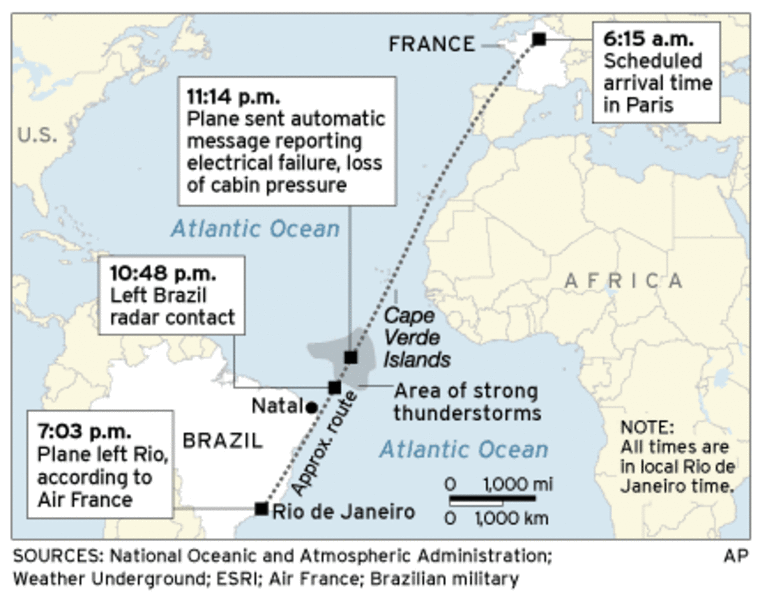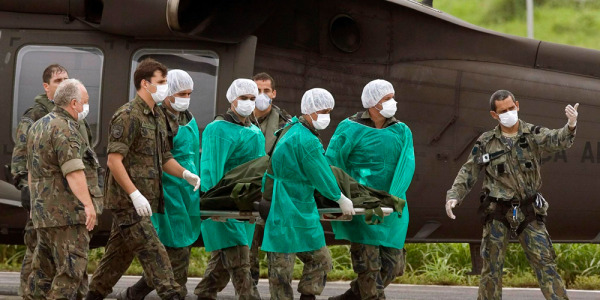Two officials say investigators in an Air France jet crash are looking at whether speed data instruments malfunctioned.
The officials, who have knowledge of the investigation, say an iced-over external probe or a bad speed sensor may have fed inaccurate data to onboard computers controlling the jet.
The officials spoke Thursday on condition of anonymity because they weren't authorized to discuss the case.
Aviation analyst Bill Voss said if the plane was traveling too fast in heavy turbulence, it could break apart. If traveling too slow, it could stall.
The Airbus A330 crashed into the Atlantic Ocean on a flight from Rio de Janeiro to Paris Sunday night with 228 people on board. Airline officials say there were no survivors.
First wreckage
Meantime a Brazilian helicopter crew recovered the first wreckage from Air France Flight 447 on Thursday, pulling a cargo pallet from the sea.
Two buoys — standard emergency equipment on planes — also were recovered from the Atlantic Ocean about 340 miles northeast of Brazil's northern Fernando de Noronha islands by the helicopter crew, which was working off a Brazilian navy ship.
Air France's CEO Pierre-Henri Gourgeon told family members at a private meeting that the Airbus A330 disintegrated, either in the air or when it slammed into the ocean and there were no survivors, according to Guillaume Denoix de Saint-Marc, a grief counselor who was asked by Paris prosecutors to help counsel relatives.
Soldiers at Fernando de Noronha's airport, where any recovered human remains would be taken, unloaded body bags and a refrigerator truck on Thursday from a military plane.
Flight 447 disappeared en route from Rio de Janeiro to Paris on Sunday night, the deadliest crash in Air France history and the world's worst commercial air accident since 2001.
With the crucial "black box" voice and data recorders still missing, investigators were relying heavily on the plane's automated messages to help reconstruct what happened as the jet flew through towering thunderstorms.
The messages detail a series of failures that end with its systems shutting down, suggesting the plane broke apart in the sky, according to an aviation industry official with knowledge of the investigation who spoke on condition of anonymity because he was not authorized to discuss the crash.
"What is clear is that there was no landing. There's no chance the escape slides came out," said Denoix de Saint-Marc, who heads a victims' association for UTA Flight 772, which Libyan terrorists downed with a suitcase bomb in 1989.
Conflicting signals
Slideshow 17 photos
Grim search for crash site
France's accident investigation agency said only two findings have been established so far: One is that the series of automatic messages sent from Flight 447 gave conflicting signals about the plane's speed; the other is that the flight path went through dangerously stormy weather.
The agency warned against any "hasty interpretation or speculation" after the French newspaper Le Monde reported, without naming sources, that the Air France plane was flying at the wrong speed.
France has invited the U.S. National Transportation Safety Board to help in the accident investigation. The U.S. team also includes General Electric Aviation of Cincinnati, Ohio, which made the plane's engines, and Honeywell International Inc. of Morristown, N.J., which made the black boxes and parts of the communication and navigation systems.

Seas were calm Thursday with periodic rain as ships converged on three debris sites to recover wreckage, but French military spokesman Christophe Prazuck said extreme cloudiness prevented U.S. satellites from helping.
"The clock is ticking on finding debris before they spread out and before they sink or disappear," Prazuck said. "That's the priority now, the next step will be to look for the black boxes."
French planes and a U.S. Navy P-3C Orion surveillance plane joined Brazil's Air Force, whose pilots guided Navy ships to debris areas across a search zone of 2,300 square miles, said Brazil Air Force Gen. Ramon Borges Cardoso.
Other debris spotted so far includes a 23-foot) chunk of plane, an airline seat, an oil slick and several large brown and yellow pieces that Cardoso said probably came from inside the plane.
Brazil's Defense Minister Nelson Jobim said debris had spread more than 140 milesapart in currents roughly 400 miles northeast of the Fernando de Noronha islands off Brazil's northern coast, where the ocean floor drops as low as 22,950 feet below sea level.
The Pourquoi Pas, a French sea research vessel carrying manned and unmanned submarines, is heading from the Azores and will be in the search zone by June 12, Prazuck said. The equipment includes the Nautile, a mini-sub used to explore the undersea wreckage of the Titanic, according to French marine institute Ifremer.
But the lead French investigator has questioned whether the recorders will ever be found in such deep and rugged underwater terrain.
Mourning in Rio
The mourning continues — more than 500 people packed the historic Candelaria church in the center of Rio de Janeiro Thursday for a Mass for the victims of crash. Some relatives quietly sobbed and others wore sunglasses to hide reddened eyes.
Carlos Eduardo Esteves, a 22-year-old law school student, came to remember Air France crew member Lucas Gagliano, a Brazilian who was on his way back home to France after attending his father's funeral.
His eyes tearing up, Esteves said they had been friends for years.
"This is a form of saying goodbye to him. I feel so much loss, the nation has lost so much."
The last message from the pilot was a manual signal at 11 p.m. local time Sunday saying he was flying through an area of black, electrically charged cumulonimbus clouds that come with violent winds and lightning. The automated messages that followed suggest the plane broke apart in the sky, according to the aviation industry official.
But the lead French investigator has questioned whether the recorders will ever be found in such deep and rugged underwater terrain.
